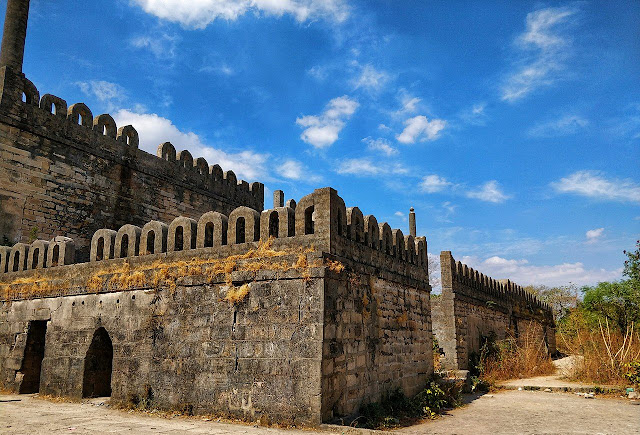History :
The fort is located in the oldest part of Junagadh and Uparkot literally means the upper citadel. The fort displays remnants dating to 2,300 years back consisting of walls that reach up to as high as 20 metres in some places. There was once a 12 year long siege in Junagadh and due to the presence of this fort it remained intact and preserved. The caves present in and around the cave premises are believed to have been dated back to 1 to 4th century AD and is believed to have been utilised by the Buddhist monks in the area during the ancient times. Every aspect of the fort depicts remarkable work of artistry and creativity complete with gilds with beautifully intricate pillars, chaitya windows etc. One can go through these structures inside the fort complex and feel closer to the ancient times when the fort was in full working conditions.
This ancient fort is believed to have been built in 319 BC by the Mauryan emperor Chandragupta, though it has been extended many times. In places, the ramparts reach 20m high. It’s been besieged 16 times, and legend has it that the fort once withstood a 12-year siege. The views over the city and east to Girnar Hill are superb, and within its walls, there is a magnificent former mosque, a set of millennia-old Buddhist caves and two fine step-wells. The fort has two fine step-wells both cut from solid rock. The circular, 41m-deep Adi Kadi Vav was cut in the 15th century and named after two slave girls who used to fetch water from it. Navghan Kuvo, 52m deep and designed to help withstand sieges, is almost 1000 years old and its magnificent staircase spirals around the well shaft. Look for the centuries-old dovecotes.
Said to have been built in 319 BC, the fort was the architectural work of Chandragupta. But the fort changed many hands. Remnants of different rulers can be seen in some parts of the structure. For example, on the rampart above the gate is an inscription of Mandalika III, dated 1450. Another emblem is in the form of a 10 inch bore cannon of bell-metal - 17 feet long and 4 feet 8-inch round at the mouth. This gun was brought from Diu, where it was left by the Ottoman Turks when they were defeated in the Siege of Diu in the mid-16th century.
Inside the Uparkot fort, you will see the famous Neelam and Manek cannons. The cannons play a role in history as well. The Ottoman Sultan sent them to fight the Portuguese during the Battle of Diu in the 1500s. You will see some other structures that are part of the medieval lifestyle, like the water wheel, two steps wells, and the old palace. One of the wells shares the names with two servant women who fetched water, Adi and Kadi, and the name of the step-well is Adi Kadi Vav.
How to Reach Uparkot Fort :
Located about 2 km from the Junagadh city centre, the Junagadh Fort can be reached with either a 10-minute drive or a 30-minute walk. The Junagadh Junction is the nearest transit head, about 3 km from the fort.
Autos are available here as well, an auto ride from the station to the fort would cost about INR 40 to INR 60. However, there are a couple of narrow streets that one would have to cross to get to the fort.
Best time to visit:
The best time to visit is between November and February.
Timings : 7:00 AM - 7:00 PM
Entry Fee : India Visitor - INR 5
Foreign Visitor - INR 100







0 Comments